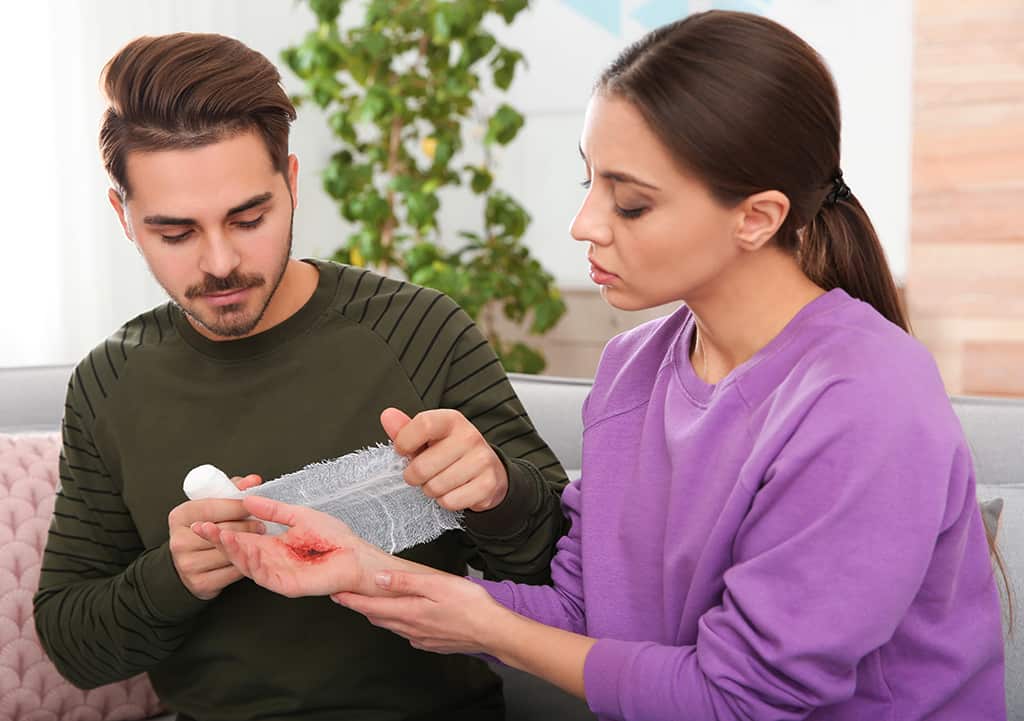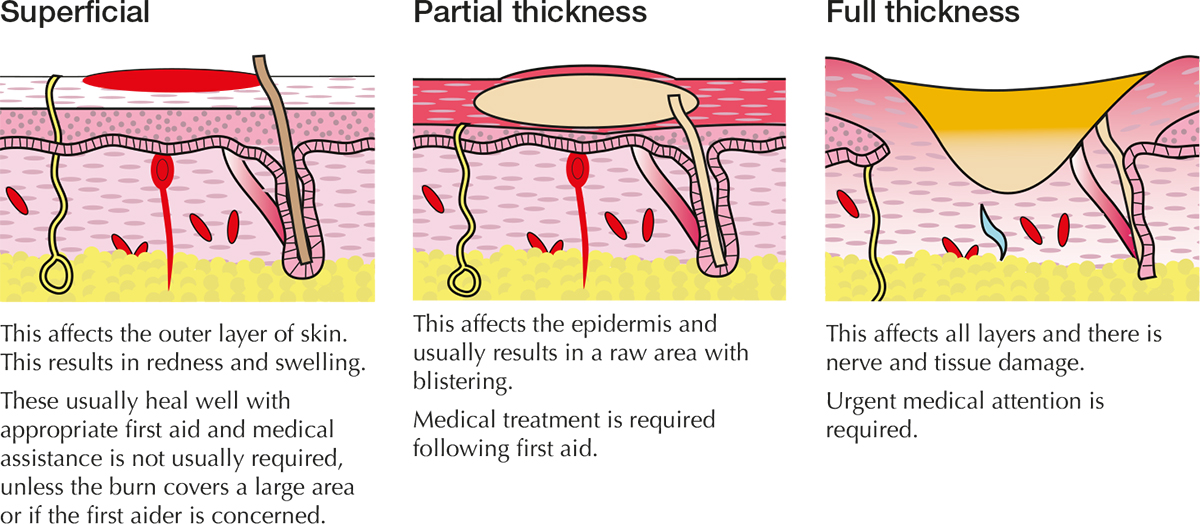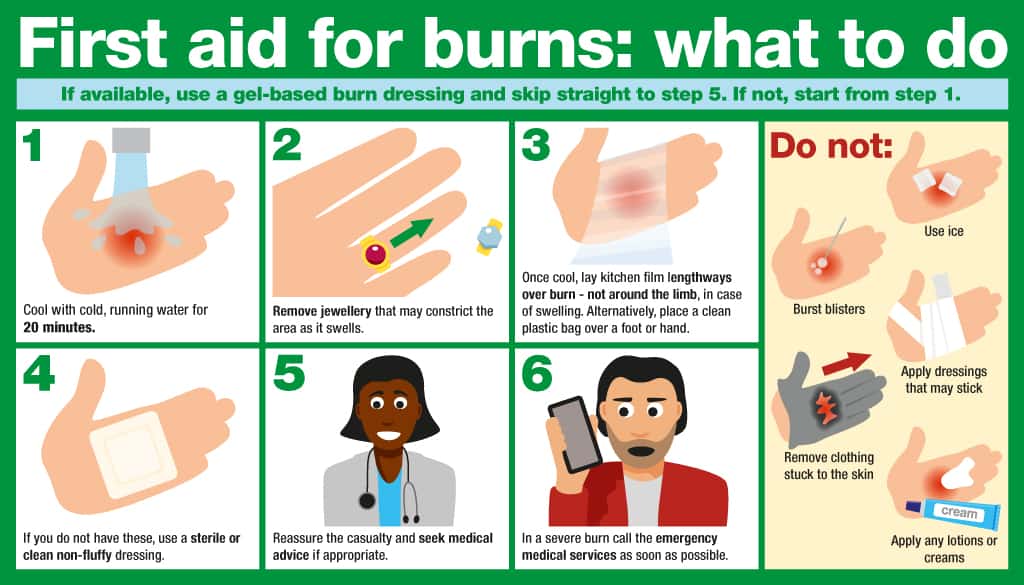
Burns are one of the most common injuries sustained at home or work and are usually caused by accidents. While burns can be very painful or potentially life-changing, most are minor and can be treated at home with first aid.
It’s estimated that a quarter million people in the UK receive burn injuries each year. Burn injuries at home frequently affect children, and parents should take special care to ensure that their children are in a safe environment.
Whether you’re a parent, spend lots of time in the kitchen, or simply enjoy resting by the fireplace during winter, first aid knowledge is essential to ensure that you’re ready to act in the event of an accident.
Immediate first aid for burns
When someone sustains a burn, there are a few immediate first aid steps that should be taken:- Stop – Get the person away from whatever is burning them to stop the burning process, this includes use of the stop, drop and roll method if the fire is on an item of clothing. Take appropriate action to protect yourself from the hazard as well.
- Cool – Immediately cool the burn preferably with running water, but if none is available use burn dressings or gel.
- Call – Call emergency services if the burn is severe or covers a large surface area.
- Cover – Cover the burn with either cling film or a sterile, non-fluffy dressing to protect it from further harm. Do this only AFTER the burn has cooled.
When to go to the hospital
As a general rule if in doubt, always seek professional medical advice. It is better to have sought advice and not need it than to hold off and make the issue worse.The main circumstances that will require a hospital visit when someone has sustained a burn include:
- If the casualty is a child
- All full thickness burns
- All burns involving the feet, hands, face or genital area
- All burns that extend around a limb
- All partial thickness burns larger than 1% of the body surface (the size of the casualty’s hand)
- All superficial burns larger than 5% of the body surface
- Burns with a mixed pattern of depth
- If you are unsure of the severity or extent of the burn
- All electrical and chemical burns
How to treat a burn

1. Cool the burn with water or burn gel.
Soothe the burn by running cool water over it for at least 20 minutes, making sure that the water is running over the burn rather than directly onto it. Alternatively, place the affected area into a bowl of cool water. When using this method, ensure that the water is changed as needed to maintain a consistently cool temperature.Burn gels offer an effective and efficient cooling option in any circumstance where access to water is difficult or impractical. Heat-absorbing water-based burn dressings are sterile and do not require additional covering.
Always avoid using ice or very cold water, as this can irritate the burn further.
2. Cover the burn with a non-fluffy sterile dressing.
After you have cooled the burn, cover the affected area with a non-fluffy sterile dressing, such as the bandages found in a first aid or burn kit. If you do not have access to a clean non-fluffy dressing, then you can use plastic cling film. If the affected area is a foot or hand, you can cover the injury with a clean plastic bag. Ensure that you apply the cover lengthways over the burn rather than around the affected area as swelling may occur.Never apply a dressing or cling film to a hot burn site. Covering should only be used after the burn injury has been totally cooled.
3. Seek medical advice if appropriate.
In the case of a severe burn that causes blisters or chars the skin, contact emergency medical services as soon as possible. Always contact them if you’re ever in doubt about a burn or if a baby or young child has been burned.Understanding the severity of a burn

What to NOT put on a burn
There are several common household items that should not be applied to a burn as they will only cause more harm to the injury. These include:Ice
Applying ice directly to a burn can restrict blood flow and excessively cool the area, potentially causing frostbite in addition to the burn. It may also increase tissue damage compared to simply rinsing the burn with cool running water.Greasy substances (butter, oil, etc) and household creams (toothpaste, Sudocrem, Savlon, etc.)
Using these products can cause the heat to be trapped, resulting in a higher risk of infection. They can also potentially lead to a slower healing process.Fluffy or adhesive dressings
Using a fluffy dressing can result in contamination of the burn site due to lingering fibres. These dressings can also get stuck to the wound and become painful to remove, sometimes causing further damage.Frequent questions about treating a burn injury

What should I do if clothes or jewellery are stuck to a burn?
Any jewellery near the site of a burn should be removed, as they may constrict the burn area as it swells. If any clothing is stuck to a burn, do not try to remove it as that may cause more damage. Clothing that is near the burn can be removed.When should I use burn gel?
Cool running water is ideal for soothing burns immediately after they occur, but there are many scenarios where running cool water over the affected area for 20 minutes is impossible or impractical. For example:
- Running water isn’t readily available
- There are multiple burn victims
- One victim has suffered multiple burns
Burn gels offer a sterile, supportive cooling mechanism that does not require water and reduces the risk of inducing hypothermia when cooling larger burn areas.
How do I take care of a burn while it is healing?
Immediately after a burn injury has been sustained, it is important that you do not break any blisters that form, apply any dressings that may stick to the wound, or apply any oily lotions or creams. After a burn has been cooled and an appropriate dressing has been applied, an over-the-counter pain reliever can be taken if necessary.While a minor burn injury is healing, the area will be fragile and need care. Consider using an antiseptic cream to soothe the affected area.
Final thoughts and recommendations
Getting a first aid or burn kit for your home or workplace is the best way to make sure you’re always ready in the case of an emergency. Signing your workplace up for a fire safety course is also a great way to reduce the risk of serious injuries at work.
Remember the three basic steps:
- Cool – Cool the burn under running water for at least 20 minutes
- Cover – Cover the burn loosely with a non-fluffy sterile dressing or cling film
- Call – Call the emergency medical services if you’re unsure or in the case of a serious burn
About the author:
Jo Stokes is a writer, marketer and trained first aider at First Aid Online.
Find out more about Jo.
By Jo Stokes

